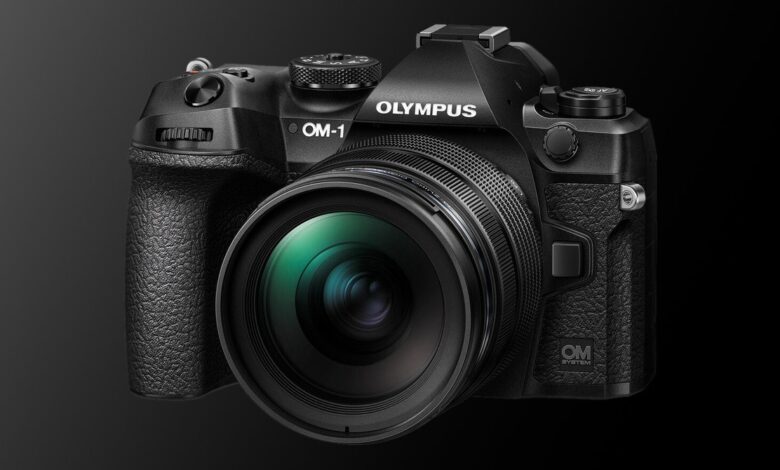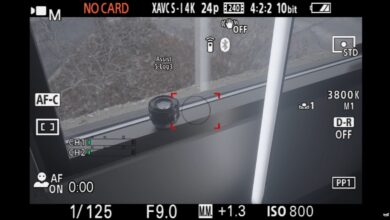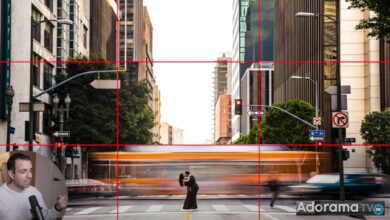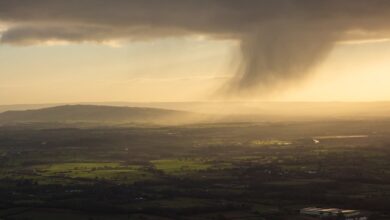The New OM-1: Impressed by the Specs? Here’s my Hands-on Review of the Camera.

I aggressively tested an OM System OM-1 Camera in the field. As I had pre-ordered one, I was hoping that I would be pleased with the results. Was I? Here are my thoughts on the camera and what it means to the future of the OM System.
First impressions of the OM1
I first trained in an engineering background. Consequently, I have always had a penchant for well-made precision instruments. When I lifted this camera from the box, my very first realization of the OM System OM-1 was how well it fits that bill; it looks and feels like a high-quality device, making it a pleasure to hold and use.
It’s slightly larger than my Olympus OM-D E-M1 Mark II – I didn’t upgrade to the Mark III – and the grip is deeper than any of the E-M1 models, making it easier to hold. The bodywork feels even more robust than my previous camera, and that survived all sorts of drops onto rocks, splashes by the sea, and dunking in rivers. Despite being only a tiny bit heavier, weighing in at just 1.32 lb (599 g), the new model gives the impression of being even tougher than both its predecessors and its competition.
Portability and Battery Life: The OM-1 is the Perfect Tough Traveling Light Camera
Despite that small increase in dimensions, It’s still a small camera. The big advantage of Micro Four Thirds is that smaller size, especially the because of the highly regarded OM System M.Zuiko lenses. I often walk with my camera attached to a wrist strap. With the 12-40 f/2.8 lens attached, it’s still just small enough to slide into my coat’s side pocket.
Moreover, I have family and friends dotted around the world. When I take my camera with me, I want it in my hand luggage, so it’s perfect for traveling. Furthermore, the OM System’s discrete design is especially useful in those places where you don’t want to draw attention to yourself.

Much of the time though, I just carry my camera attached to my tripod, with an ND filter in one pocket and a spare battery in the other. I don’t haul bulky camera bags around. I plan my shots, taking only what I need. Now, I can sometimes even leave my pockets empty as the camera has a built in 6-stop ND filter. The battery’s charge longevity is great too, so I don’t need to take a spare one of those.
My old camera’s battery would run down when shooting multiple long exposures, or spending a few hours capturing wildlife. With the OM1, I came home from the first 2-hour test shoot with over 1000 photographs taken over two hours. The battery had only dropped from 90% to 70% charge.
Moreover, further tests showed that the in-body image stabilization is so good, I can even leave the tripod at home for many shoots; Olympus were always ahead of the stabilization game.
The in-camera USB charging is another attribute useful dimension for travelers.
With that size and weight saving, coupled with the IP53 rating, I can see this camera appealing to outdoor activities enthusiasts where weight and durability count. IP means ingress protection, the 5 means protection from dust, and the 3 is spraying water. In other words, it should stand up to desert and rainforest conditions. Its freeze proof rating means it is reliable in use for temperatures down to 14°F (-10° C), so great in winter conditions too.
Oops! I Shot it Again, and Again, and Again
I should explain those 1000 shots. In my rush to set the camera up the night before, I had accidentally programmed one of my custom modes to Pro Capture. This recorded seventy images to the buffer before I had fully depressed the shutter release, when it loaded them onto the memory card. It then continued recording at 120 frames per second once I fully pressed that button. Lesson learnt; I’ve since set the frame count limiter and slowed the frame rate. Nonetheless, it did mean that I got the shot.
As I shoot in silent mode most of the time, saving the very generous 400,000 shutter life, one big difference I noticed was the lack of blackout between frames when shooting at the fastest frame rate. This is a good thing, although I did wonder whether the camera was taking photos at first.
The On1’s Ergonomics and Usability
As I mentioned, I graduated to this camera from the E-M1 Mark II and not the Mark III, and I noticed a marked difference in the positioning of the buttons. For users of the Mark III this will be less of a challenge, although the front dial is now recessed in the body, as opposed to sitting on top, and the top buttons by the power switch have a lower profile too. My muscle memory is still learning these new positions. The AF-On button is new to this camera and, until I got used to it, my right thumb went automatically to the AEL button to back-button focus.
But the important thing for me is that it is comfortable to hold in my big hands. Despite the diminutive size of the camera, my long fingers can easily manipulate the buttons.
Shooting with gloves wasn’t a problem. However, I do wear warm, tight fitting technical gloves made for extreme outdoor pursuits. Loose fitting, thick gloves may be a hindrance, but the same could be said of using any camera.
Putting the OM1 to the Focussing Test
The focusing is fast and accurate and there are several factors at play here.
Geeky photographers like me will want to discover why the Quad Pixel system with 1053 cross type phase detection points that cover the entire stacked sensor make a difference. I suspect most photographers though will just be impressed that it does. Although that technical jargon sounds remarkable, you don’t have to know how the auto focus works to discover that it does, and does it well.
Most of my work is shooting seascapes, so that focussing speed is less important to me, but being able to focus at the extremes of the frame is a boon. Yet, I also enjoy capturing photos of birds, and I did notice a significant improvement in focussing speed, even when using my old Four Thirds Zuiko 50-200 mm 1:2.8-3.5 SWD lens.
Switching on the subject recognition feature, my success rate for capturing birds leaped up enormously. Then, using the in-body focus limiter, which allows setting three different distance ranges anywhere between 0 to 999.9 meters, I could restrict the minimum and maximum subject distance, thus reducing focusing time even more.
The AI subject recognition is first class. It quickly detects subjects and holds focus. Even when photographing sparrows in my back yard, the camera locked onto birds even when partially obscured by the twigs and leaves of my neighbor’s tree.
It would even identify and lock onto birds that were too distant to photograph, great when capturing birds flying towards you.
In single auto focus mode (S-AF), the camera mainly uses contrast detect. I guess this is because, no matter the camera, contrast detect is more accurate. That accuracy is especially important for close-up and macro photography. I use the word “mainly” as it is supported by the phase detect system, which I presume is to add extra speed, and also enabling focussing in low-contrast situations.
In continuous autofocus (C-AF) it uses solely the faster phase detect system, essential when shooting moving subjects.
Are the Noise Control and Dynamic Range Better?
The new OM-1 has much, much better noise control than previous models, two stops in fact, and this is noticeable both with higher ISOs and long exposures. If you are not familiar with what stops are, each stop is double the previous value, so two stops are four times better. This is thanks to the new TruePic X image processing chip working in tandem with the Stacked BSI Live MOS Sensor.
I tried both high ISOs and long exposures and was pleased by the improvements. With the advent of AI noise reduction, such as Topaz Denoise, DxO Deep Prime, and On1 NoNoise, clean, sharp images should be achievable at high ISOs, once the various processing and editing programs are updated to handle the camera’s raw files. Be sure to also download the free AI Noise Reduction software for the OM Workspace software, but only if you graphics card has more than the 4 GB of VRAM minimum requirement.
I carried out a quick test of the ISOs, and these are the results, without Noise reduction.
The In-Built ND Filter Opens and other Computational Techniques
The computational photography facilities of Olympus cameras were always a hidden gem that their camera owners loved. Unlike the old Olympus, OM Digital Solutions are rightly highlighting these features, some of which are unique to the brand.
The image below was a handheld 3-second shot combining the inbuilt ND64 with my URTH ND1000 screw-on filter. To the right is an approximately 200% enlargement showing the sharp detail of the island that is just over a mile distant. No exposure compensation was added, and although shooting contre jour, details can be seen in the shadows.
This next image was again a handheld 1-second exposure with a 15mm focal length

Previously, on a bright day, I would struggle to get a one second exposure using just the ND1000. Combining the two, I can extend that to up to a minute-long exposure. That’s something I could only achieve before by stacking filters.
The following was a 17 second exposure, using Live Time. That allows me to watch the image gradually develop on the rear screen. Again, the noise control was superb. This was shot before sunrise with the ND 1000 filter fitted.

As yet, I haven’t tried light painting with the camera using Live Composite mode. I would be embarrassed putting my results out there when Hannu Huhtamo is out there creating astounding art. This amazing feature, unique to OM System cameras, shoots a frame and then only adds new light to the shot, allowing Hannu to create these marvelous compositions.
Video and Other Features Worth a Mention
Video would need a whole new review of its own, so I am just going to brush over it here. Historically, Olympus stood back with its video specs, leaving that to Panasonic to rule the roost in the Micro Four Thirds field. But there has now been a huge leap forward with the OM-1. Especially so with its 4K/60p with 10-bit 4:2:2 color depth, and the 120 fps at 1080 – enabling slow motion shooting – capabilities, and its raw output.
I wonder whether OM Digital Systems will start producing dedicated video lenses without graduated f-stops.
The dust cleaning system is as good as ever. I have never had to clean dust from any of my previous Olympus cameras.
The camera also has HDR modes, combining multiple exposures into a single raw file; in-camera focus stacking compatible with pro lenses; a high-resolution mode, creating up to 80-megapixel images using sensor shift technology, including a hand-held version; plus a multiple exposure mode where you can see the image you want to overlay within the viewfinder before you shoot the second image. There’s also “Starry Sky AF” that ensures the night sky is sharply focussed.
Finally, the color reproduction seems to be spot on. I matched test shots against the original items, and they seemed identical using the “Natural” picture mode.
Will this Camera be a Success?
This camera lives up to the exacting standards of the first camera to bare the OM-1 name half a century ago. But, will it be as successful, and what does this all mean for the future of the OM System?
Now OM Digital Solutions is not shackled to developing technologies that must also be of use to the medical industry, it appears to be concentrating on doing what, historically, it it did best: making innovative first class cameras that meets the needs of photographers. Their ongoing pushing of the boundaries of what a camera can do has to be good for the industry as a whole.
In many countries OM Digital Solutions have been taken aback by the initial demand. The huge numbers of pre-orders mean the OM1 sold out their first two months of stock before it hit the shelves. Several suppliers are on back-order, so those buying now will have a short wait before their camera arrives, but OMDS are increasing the supply to meet the shortfall. This is a different situation from the recent delays with the Olympus 150-400 pro lens where production could not keep up with demand.
I contacted Mark Thakara, Content & Community Senior Manager at OMDS about this.
We have been quietly confident for some time that this model would do well. We planned accordingly and substantial stocks have arrived on time around the world ready for initial shipments. Reaction and order intake for the OM-1 have more than exceeded our forecasts. We are excited about the growing enthusiasm and high interest in the OM SYSTEM brand and we would like to manage expectations a little. Our successful pre-order promotion does mean not everyone will get their OM-1 right at the start but more will be on the way on a regular basis from now on. Therefore, we recommend customers contact their local retailer to confirm availability. We appreciate the understanding and can assure everyone that this camera is worth any possible wait.
What I liked about this Camera?
I make my living from photography, but only because I enjoy it so much; if I didn’t, I would do something else. I need photography to be pleasurable, and this camera is a delight to use. There are plenty of reasons why I am pleased with it:
Firstly, I enjoy learning, and there is a lot to learn with the OM-1.
Next, there is a big leap forward in image quality; the increased dynamic range and operating speeds are noticeable in the real world, thanks to that new sensor and powerful processor that enable all the unique features mentioned above.
Third, I am glad that OMDS chose to listen to the Micro Four Thirds users and make improvements where they were needed, and not chase more megapixels, as dictated by the big brand marketing departments. I don’t need bigger files.
Then there is the menu improvement. That will make it much more accessible for new users. It’s color-coded and the sub-menu names are better. Although a different layout from its predecessors – I liked the previous version – it is still familiar enough to not seem completely alien. Furthermore, the four custom modes, and the customizable “My Menu” means that delving into the depths of the menu system is usually unnecessary. What is more, if something is grayed out, on the press of the Ok button, a dialog box can tell you why.
Fifth, I find the camera comfortable to use, and the buttons easy to reach, and its name is much less of a mouthful than its predecessors. It also feels really well made too. Plus that new EVF is crystal clear.
Sixth, the computational photography features are useful in the real world, and not gimmicks like fake bokeh. This is a serious photographer’s camera.
What Could be Improved
There is only one area of improvement that struck me: I wish the removable-battery charger had been included in the box. The USB-C charger and in-body charging is great, but I prefer to have my camera safely stored while I charge batteries. I also try to avoid long-term use of sockets and body covers to prevent wear. Plus, in some circumstances, I want to charge one battery while I am using the other. Consequently, the additional battery charger is on my shopping list. But that’s a tiny gripe; I know photographers who are happy with in-body charging.






